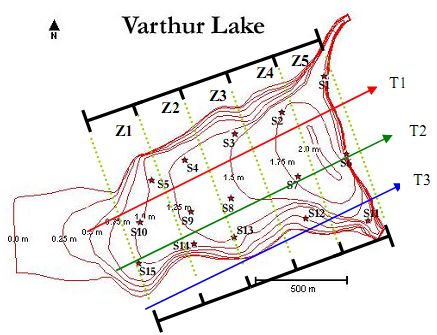SPATIO-TEMPORAL VARIABILITY IN C: N RATIO
A significant spatial and temporal variability of water quality
in terms of organic compounds and nutrients, with a
considerable decrease in the organic matter as water flows
from inlet to the outlets during the seasons devoid of
macrophytes cover in the lake was observed. Varthur Lake
serves as a source for irrigation to the cultivable lands and
vegetable cultivation together with horticulture and
floricultural activities and has a surface area of 220 ha (Figure 1). The lake was built by the Ganga Kings (Gazetteer of
Karnataka) to store water. The lake initially was a deep with
water which was used for drinking and other domestic
purposes, intense urbanization have dwindled the catchments
for the last few decades. During the last two decades there are
large scale changes in land use paving way for rapid decline in
the number of lakes and eutrophication.
Figure 1. Bathymetric map of Lake Varthur, Bangalore (India).
The large dot with the star’s indicate the sites where surficial
sediments were taken (S1-S15) and contours represent the
various depths of the Lake.
